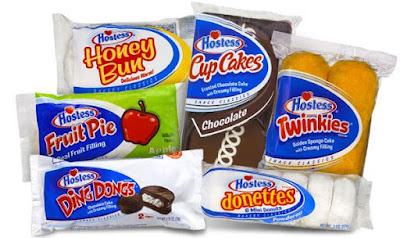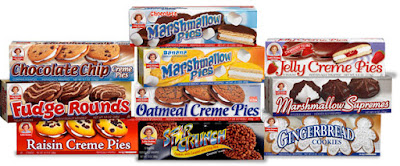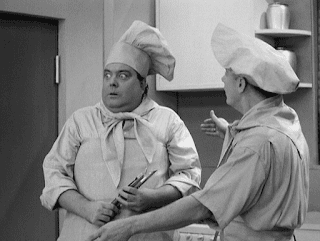If you read the announcement post for this new "Lunchbox Series," I mentioned I had my memory jogged about an all-out media frenzy a few years ago over Hostess's bankruptcy and sale. After reflecting on those events, I decided to do a deep dive into the companies that I often found in my lunch box as a kid. I have fond memories of opening my lunch box to see, right next to the Ecto Cooler and the ham and cheese sandwich, a Hostess snack cake. I'm sure many of you have memories of opening your lunchbox to see these snacks, too!
Let's start Part One of the "Lunchbox Snacks of YesterYear" series on the Big Daddy of them all: Hostess!
Hostess's story is a weaving and intricate tale of mergers and acquisitions that date back to 1849! Stick with me here; it's a fun story and worth your time if you have even the slightest hint of interest in Hostess or business empire-building in general.
Enjoy!
The story of Hostess starts way back in 1849. That year, Robert Boyd Ward created Ward Baking Company in New York City. His grandson, William, took over the company in 1921. William made several bold moves over the years, and in 1925 renamed the company Continental Baking Company. That same year, he purchased Wagner Baking of Detroit, Michigan. Then, in his boldest move yet, he acquired Taggart Baking, the maker of Wonder Bread.
These moves made Continental the largest commercial bakery in the United States at that time.
An interesting story worth telling before we really get going: On May 19, 1921, a mysterious advertisement showed up in The Indianapolis Star newspaper. The ad asked readers a cryptic question: "Wonder? How often do you use this word every day? Check yourself."
Two days later, another mysterious ad ran. It still didn't reveal what product or company was being promoted, but readers were promised that a "real WONDER" would soon be found and that readers "would never find a WONDER of a better kind."
A few days later, Taggart Baking Company ended the wondering and ran a large advertisement in The Indianapolis Star, announcing the arrival of its new "WONDER BREAD!" The first loaves of Wonder Bread hit grocery stores on Tuesday, May 24, 1921.
Taggart Baking opened in 1869 as Parrott-Taggart Baking Company of Indianapolis. The company boomed after the Civil War, and the company merged with the fledgling National Biscuit Company (NABISCO) around the turn of the century, but at that time, they continued to use the Parrott-Taggart name. Taggart sold his stock in the company in 1904 and created his own Taggart Baking Company. Within a year, he had the largest bread bakery in Indiana, making 300,000 loaves per week. By 1913, they decided to expand to "fancy cakes and sweet crackers."
To assuage customer concerns about the cleanliness of a "factory-made" baked good, Taggart painted everything, including the ovens, a crisp white. Machines quickly replaced humans, including icing the pastries and packing the baked goods.
Wonder Bread became a national brand when it was purchased by Continental Baking Company in 1925. It became the nation's first sliced bread, which inspired the catchphrase "the greatest thing since sliced bread."
With the nationwide success of Wonder Bread, Continental Baking Company created the brand name Hostess in 1925 and began developing other snack cakes.
In 1930, The Twinkie was born when Continental employee James Dewar developed the spongey cake as an inexpensive product to produce (and purchase) during the Great Depression.
In 1947, Hostess created the Sno-Ball cake, and in 1967, the Ding Dong and Ho Hos debuted.
Continental was purchased by Ralston Purina in 1984 before being purchased by Interstate Bakeries a decade later in 1985.
Interstate Bakeries has a fascinating history in its own right. Hostess wouldn't be what we know it today if it weren't for Interstate, so let's take a more in-depth look!
Interstate Bakeries has roots that reach back to 1905 when Ralph Nafziger launched Nafziger Bakeries in the basement of a church in Kansas City. As he grew the business, Ralph expanded by buying his competitors. In 1925, Ralph sold Nafziger Bakeries to Purity Bakeries (which would eventually become American Bakeries). He used the money from the sale to purchase a controlling interest in Schulze Baking Company, which had been successful in selling Butternut Bread.
In 1930, Nafziger then announced his creation of Interstate Bakeries Corporation (IBC) when he merged Schulze with Western Bakeries of Los Angeles to become the fifth-largest baker in the United States. IBC originally began selling Butternut Bread to grocery stores nationwide after expanding in 1937 with the purchase of Supreme Baking Company in Los Angeles, and in 1950 they expanded again with the acquisition of O'Rourke Baking Company of Buffalo, New York.
Rapid expansion in the 50s and 60s included the Ambrosia, Remar, Butter Cream, Campbell-Sell, Schall Tasty, Kingston Cake, Cobb's Sunlit, Sweetheart Bread Company, and Hart's Bakery. IBC continued to expand throughout the late 60s by acquiring Millbrook Bread and Shawano Bakeries and their respective canning companies.
Rapid expansion in the 50s and 60s included the Ambrosia, Remar, Butter Cream, Campbell-Sell, Schall Tasty, Kingston Cake, Cobb's Sunlit, Sweetheart Bread Company, and Hart's Bakery. IBC continued to expand throughout the late 60s by acquiring Millbrook Bread and Shawano Bakeries and their respective canning companies.
In 1969, IBC officially changed its name to Interstate Brands. At the time, Interstate Brands was best known for its signature bread brands Butternut Bread and Blue Seal Breads, along with Dolly Madison brand cakes and desserts.
In 1975, Data Processing Financial and General Corporation (DPF), a computer-leasing firm that had encountered IBM's anti-trust issues. To change its business model to appease the courts, Data Processing Financial used its cash to purchase a low tech company, specifically Interstate Brands. The two merged and placed the new company headquarters in Hartsdale, New York (only 8 miles away from IBM in Armonk, New York.) The new company invested heavily in its bakery facilities and purchased the Silver Loaf Baking Company, Eddy's, and Mrs. Cubbison's Foods.
Things stabilized for the company for a few years until 1981, when DPF, seeing more long-term profit in baked goods than computers, completed the sale of its remaining computer systems. DPF changed the company name back to Interstate Bakeries and relocated the headquarters back to Kansas City.
In 1986, Interstate acquired Purity Baking Company (not the one Ralph Nafziger sold his company to back in 1925) and Stewart Sandwiches. A year later, they expanded again by purchasing Landshire Food Products.
In 1988, Interstate Bakeries turned itself into a privately held company and changed its name once again to IBC Holdings. Soon after going private, IBC bought the Merita-Cotton's Bakery division of the American Bakeries Company (this would be the one that Mr. Nafzinger sold his bakery to).
In 1991, they again sold stock in the company and became a publicly-traded company under the name of Interstate Bakeries. Dizzy yet?
Four years later, in 1995, the two companies I've detailed so far, Continental and Interstate, come together.
The world-famous Wonder Bread and other popular Hostess brands like The Twinkie would finally join Interstate Bakeries when they purchased the Continental Baking Company from Ralston Purina. The deal was made for $330 million and 17 million shares of Interstate Stock.
Shortly after the merger was complete, the new company purchased the San Francisco French Bread Company, John J. Nissen Baking Company, My Bread Company, and Drake's.
I'll be covering Drake's in more detail in this "Lunchbox Snacks of YesterYear" series, so stay tuned!
After the merger with Continental, Interstate now had two nationwide bread divisions: Butternut and Wonder Bread. The two could not be any more different, and it caused more than a few problems for Interstate. Butternut was unregimented, where each bakery was a self-contained profit center, meaning they controlled costs and kept the profits for what they produced. Wonder Bread was very structured and was used to being controlled by the parent company in terms of cost and shared profits.
The snack cakes Continental had been making, like the Hostess brands, were more profitable due to the economy of scale and the logistics of shipping smaller items with a longer shelf life than bread loaves. When extended-shelf-life enzymes were created for bread, the company hoped to convert the smaller, less-efficient bread bakeries into a network of larger bakeries to mirror the snack-cake operation.
The public response wasn't great, as the new enzymes gave the bread a different taste and texture. Less demand and cheaper competition from new bakeries in Mexico had led to lower prices in stores, reduced sales, and a deeply reduced profit.
On September 22, 2004, Interstate Bakeries filed for Chapter 11 bankruptcy protection. The company stock, which had been trading at $34/share, fell to $2/share.
Still in bankruptcy proceedings in 2007, in what was at one time the longest-running bankruptcy proceeding in American history, Interstate was forced to fight a takeover bid from Mexican baker Grupo Bimbo. Bimbo is a name you'll likely hear a lot about this month during my Lunchbox Snacks of YesterYear series.
During the five-year bankruptcy period, Interstate closed nine of its 54 bakeries and more than 300 outlet stores. Its workforce declined from 32,000 to 22,000. The company dropped regional brands and operating agreements, such as the contract that produced Sunbeam Bread for the northeastern United States.
 |
| The Hostess Bakery on Route 110, Melville, NY |
I have to step in and tell a little personal story here. I went to college in Farmingdale, New York, on Long Island. I moved to the Island in 2002 for college and never really left. My wife grew up here. The college was on Route 110, and just north of the school was a Hostess/Wonder Bread bakery and outlet. It smelled AMAZING when you would drive by with the windows down. I never had the opportunity to go in there, but I always imagined it was full of wonderful things and that I'd probably max out my credit card and gain 40 pounds before I left the building. It was about this time that, in 2009, this facility closed. It was a sad day, as it had been there for decades.
In February of 2009, Interstate Bakeries finally emerged from bankruptcy court as a private company. This private company now had a 50 percent equity stake from Ripplewood Holdings and credit extended from General Electric Capital. The unionized workers of Interstate made several contract concessions in exchange for company equity, as well.
On November 2, 2009, IBC became named for its most lucrative division, changing its name to Hostess Brands. Hostess Brands continued its bread lines, including their biggest seller, Wonder Bread. The company's subsidiaries, such as Interstate Brands Corporation and IBC Sales Corporation, continued displaying their name and logo on Hostess Brands products.
In December 2011, it was reported that Hostess Brands was ready to file bankruptcy again. The company stopped future pension payments after August, breaking union contracts. A month later, on January 10, 2012, Hostess Brands filed for Chapter 11. In the legal filings, they stated that competition was not the problem, but "legacy pension and medical benefit obligation and restrictive union work rules." Hostess said they employed 19,000 people and were more than $860 million in debt.
A fun little tidbit, but the court discovered that while all of this was going on, Hostess's new executives had given themselves raises of up to 80% the previous year. As a compromise to employees, the four top execs' salaries were cut to just $1.00, to be restored on January 1 of the following year.
In November 2012, things just got worse as Hostess employees nationwide went on strike. The Bakery, Confectionery, Tobacco Workers, and Grain Millers' International Union (BCTGM), which represented 6,600 employees at Hostess, created the work stoppage after the new proposal from Hostess management was rejected by 92% of its members.
On November 16, Hostess announced that it would be ceasing operations and be laying off most of its 18,500 employees. The company intended to sell off its assets and well-known brand names and liquidate the entire company after its 107-year history.
About this time, there was a ton of media hype surrounding the liquidation. I remember article after article with headlines like "WHERE WILL I GET MY TWINKIE!?" and "BYE BYE, FRUIT PIE!" Perhaps the news seemed like a frenzy since it was just local in nature because we had the plant right down the road and many outlet stores on Long Island. Or, maybe I just like to pay attention to stuff like this. I can just picture my wife rolling her eyes behind my back and politely listening as I continued to bring up the latest news about Hostess' financial misfortunes.
Hostess Brands' liquidation plan was finalized by a federal bankruptcy judge on November 29, 2012, and the company's name eventually changed to "Old HB." After many potential buyers expressed interest in acquiring Hostess (the brand), Hostess Brands (the corporation) announced it had received serious bids for separate assets from companies like Walmart, Target, Kroger, Flowers Foods, and Grupo Bimbo.
On January 15, 2013, Hostess sought out initial bids on its snack cake division and received offers from four companies: Grupo Bimbo, Apollo Global Management, Hurst Capital, and McKee Foods.
It was later announced on January 28 that United States Bakery was the leading bidder and new home for the Hostess Company brands Sweetheart, Eddy's, Standish Farms, and Grandma Emilie's.
McKee Foods (owner of competitor Little Debbie) became the new owner of Drake's brand of snack cakes for $27.5 million and began selling the products in September of 2013.
And on March 11, Apollo Global Management made a $410 million bid for the Hostess line only of snacks, including Twinkies and the Dolly Madison brand.
.
The "New" Hostess Brands, under Apollo Global, reopened the Emporia, Kansas plant on June 6, 2013. A press statement was released saying production would resume in ten days, and on June 23, its brands would be back on shelves by July 15. New company president Rich Seban suggested they would be experimenting with gluten-free, higher fiber, and lower sugar or sodium products.
Flower Foods, the maker of Mrs. Smith's Pies, Keebler, and Sunbeam, purchased 6 brands, including Wonder Bread. The $390 million deal included Butternut Bread, Home Pride, Merita Bread, Nature's Pride, and Wonder Bread. IT did not include Beefsteak Brand, which was purchased by Grupo Bimbo.
Lewis Brother's Bakeries purchased the following brands from the bankrupt Hostess in December of 2013: Blue Ribbon, Braun's, Bread du Jour, Continental, Countess, Country Fair, D'Agostino's, Daffodil Farms, Di Carlo, Millbrook, Old World, Ozark Mill, Pantry Pride, and Weber's.
The Baker's Inn and Dutch Hearth brands remain unsold.
Over the years, Hostess had several different creations in the packaged snack cake world.
Calling them "every day treats," Hostess currently produces (in a variety of flavors):
- The Twinkie (needs no introduction here but a vanilla cake with creme center)
- Cupcakes (Chocolate cake, chocolate icing, vanilla creme center, 'iconic' vanilla squiggle on top)
- Ding Dongs (Chocolate cake, dipped in chocolate, vanilla creme middle)
- Brownies (Chocolate cake brownie, chocolate icing, chocolate chips)
- Zingers (Vanilla cake, vanilla icing, vanilla creme center)
- HoHos (Chocolate cake with vanilla creme swirl)
- Snowballs (Chocolate cake with vanilla creme, dipped in marshmallow, pink coconut coating)
- Suzy Q's (Chocolate cake, vanilla creme)
- Fruit Pies (Flaky pastries with fruit-filled center)
Under their "Breakfast Treats" line, they currently produce (in a variety of flavors):
- Coffee Cakes (Individually wrapped cinnamon Coffee Cake)
- Donettes (Miniature Donuts)
- Jumbo Donettes (A larger-sized version of the Donettes)
- Mini Muffins (Small muffins, served in multipack)
- Mega Muffins (Larger muffins, served individually)
- Cinnamon Roll (Large Cinnamon Roll, individually served)
- Jumbo Honey Bun (Glazed pastry)
- Cake Slices (individually served Pound Cake)
- Danish (individually served pastry filled with fruit filling or cinnamon)
Since becoming their own company in 2013, and not just a brand owned by another company, Hostess has started baking bread under their own name. They currently produce:
- Bread (White or Wheat loaves)
- Bagels (Plain or Cinnamon Raisin multi-pack)
- Buns (Hot Dog or Hamburger buns)
Over the years, Hostess has created a fan following for many of their snacks. Besides the people who stop by the gas station, 7-11, or whatever local convenience store every morning for their coffee, you often see people get the same Hostess (or similar) snack every morning. Unfortunately, either through poor sales or cost-cutting decisions in bankruptcy, production on some of the beloved snacks of YesterYear come to an end.
Here are a few to tickle your nostalgia bone:
Chocodiles- A chocolate-dipped Twinkie. They still make a chocolate Twinkie, but the Chocodile mascot, and the name Chocodile, was adorable.
Pudding Pie - Similar to the Fruit Pie, this pastry was filled with vanilla or chocolate pudding. As a kid, I loved the Teenage Mutant Ninja Turtle "Turtle Pies." A Turtle Pie was essentially a Pudding Pie dipped in green frosting and was filled with vanilla pudding.
Choco Bliss - This one totally escapes me but has a pretty rabid fan following online. It was introduced during the 1980s and was billed as "A Chocolate Lover's Dream." The two Devil's Food chocolate cakes were larger than a Twinkie and filled with a chocolate creme. If that wasn't enough, the two cakes were then coated in a chocolate frosting!
Orange Ding Dongs - These were regular Ding Dongs but with bright orange frosting. They weren't heavy on the citrus flavor, just a light orange creme flavoring. Also, as orange is my favorite color, why wouldn't I like these?
Leopards - Regular Twinkies with chocolate chips in them. The branding and cartoon cat on the box were cute, and who doesn't love a little taste of chocolate in their cake? I think the branding sold this one for me.
Grizzly Chomps - These were chocolate cupcakes with sprinkles that were advertised as "97% Fat-Free." Perfect for the Low-Fat craze of the 90s, every cupcake had a single bite taken out of it already. The bear logo was cute, and I loved the bright colors used in the branding, but they didn't taste that good. The catchphrase "I start them, you can finish them," and the half-eaten cupcake never caught on.
Tiger Tails - I've never seen one in person, but it's a Twinkie produced mostly for Europe and the Middle East that features a swirl of raspberry on top (to look like the stripes on a tiger's tail) and featured a light coconut flavoring.
Phew, we made it! Thank you for sticking with me through this long-winding tale of one of, if not my favorite, snack brand's history. I have many memories of purchasing these snacks at a convenience store on road trips, while I'm away at work, or, more importantly... opening my lunchbox at school to find Mom had included one.
Next up on our "Lunchbox Snacks of YesterYear" journey is a brand mentioned a few times throughout Hostess's history...
Drake's!



















.png)




Comments
Does anyone remember the little snack cakes from the 1960s that came in a cellophane 2-pack that consisted of a flat gingerbread cake (with raised edges) that was filled with a layer of banana cream? I used to get them in my lunchbox in the mid 1960s. I don't remember if they were a Hostess brand or someone else but I loved them and haven't seen them since my school days.
ReplyDeleteHi there, was it Little Debbie "Banana Twins?" https://www.littledebbie.com/images/snackproducts/products/8c12123430b67ef26c0fdd9dac61ae7c.png
DeleteBanana Twins would have been made by Dolly Madison back in the 60s. Little Debbie took over production when they bought the Dolly Madison company.
DeleteDoes anyone remember a lunchbox treat of late 50’s- 60’s wrapped in cellophane, similar consistency of a Twinkie, gold in color, BUT, folded like a taco with crème inside?
ReplyDelete